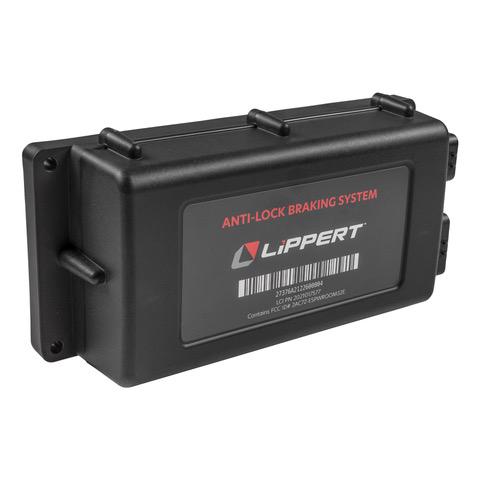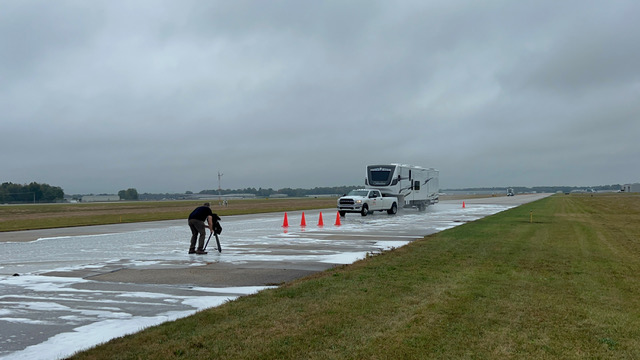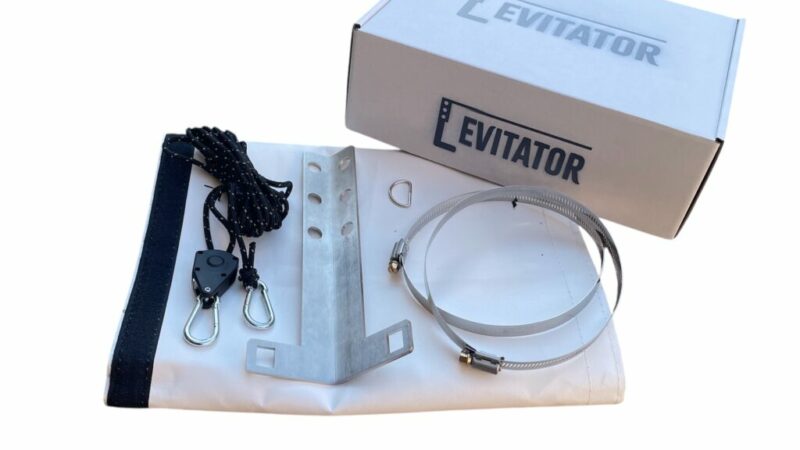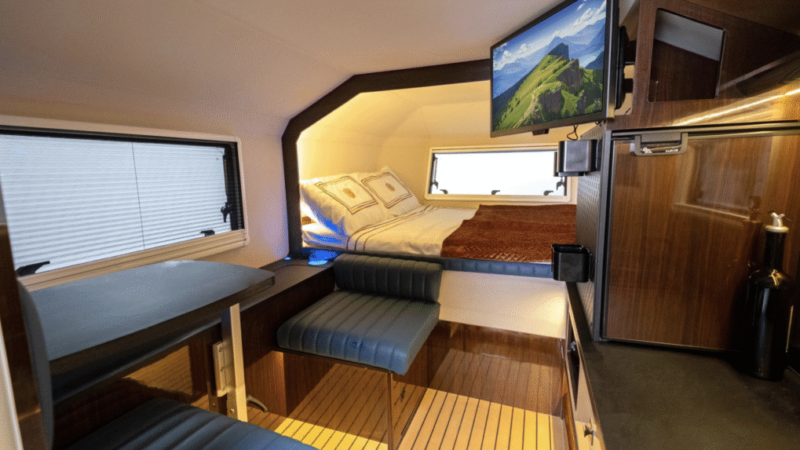Lippert’s Test Track Shows Off ABS, Suspension Upgrades – RVBusiness – Breaking RV Industry News
RVBusiness got a chance to spend the day with component supplier Lippert at the Elkhart Municipal Airport where a specially-prepared surface laid the groundwork to demonstrate new trailer braking and suspension technologies.

Anti-Lock Braking
To set the scene and truly demonstrate the system, Lippert secured a runway at Elkhart Airport. On that runway, officials rolled out a long stretch of vinyl flooring and then brought a water truck with soapy water to simulate winter road conditions. Cones were set-up on the track to measure established stopping and measuring points and another row of cones was set-up to provide an obstacle in the roadway.
Three pickup trucks towing three different fifth-wheel trailers were provided for the day with each of those fifth-wheels having the new Lippert ABS. Then we were loaded into the cab of the trucks and taken down the runway.
The first pass was simply a dry runway demonstrating how quickly the truck could stop with the trailer in tow. This is no mean feat as these trailers were about 12,000 pounds each. It was remarkable how quickly the truck and trailer were able to come to a halt from about 45 miles per hour.
While the driver stood on the brake pedal (figuratively), the truck and trailer maintained a sure, straight path on the dry surface.
Our next pass we were back up to 45 miles per hour, but this time we were headed for the soapy vinyl flooring. Again, the driver fully applied the brakes and, while the stopping distance was much longer owing to the slipperiness of the surface, the truck and trailer stayed true to the direction dialed-in by the steering wheel.
Typically a trailer without anti-lock braking would likely brake differently than the tow vehicle, and would likely come around and potentially cause the driver to lose control of the whole rig. With this much weight this could prove disastrous and dangerous.
Our final pass was back up at 45 miles per hour, but this time our course had an obstacle in it. The driver applied maximum braking but also steered the rig to avoid the obstacle. Again, we were on the slippery vinyl that simulated winter road conditions.
Despite the challenging conditions, the trailer followed the truck through the course without any drama. The driver was able to maintain control the entire time without having to do anything radical.
Anti-lock braking technology essentially “pulses” the brakes so that the tires don’t lose traction which allows the driver to maintain control of the vehicle. If a tire starts to skid you now do not have control of the vehicle which can be disastrous, of course. Add a slippery surface and it becomes even worse.
Final thoughts on ABS
Honestly, being in this very heavy rig and watching how the entire thing performed over both good and poor road conditions was absolutely eye-opening. Anti-lock braking has been required to be a part of most passenger vehicles since 2011, but is only now becoming available in towable RVs.
Lippert’s anti-lock braking system is currently available to OEMs with Forest River, Keystone and Grand Design being the first to the plate with the technology. It will eventually be available in the aftermarket as well.
Fifth-wheels with the technology will be obvious on a dealer’s lot with the brake drums being painted a red color.
In addition to anti-lock braking, the technology also enables an owner to track mileage of the trailer. There is also some sway mitigation technology built into the system.
This kind of technology changes the game from a safety standpoint and can truly make a difference in the outcome of a challenging panic stop. It is now required on all vehicles because of the improvements in braking safety.
Adding the anti-lock braking to a trailer doesn’t require a tremendous change to the trailer, other than adding some wiring and the control module. There is no change required to any tow vehicle nor to the seven-pin connection between the tow vehicle and trailer.

Suspension animation
We also got to ride in three fifth-wheel trailers on a patchy stretch of runway to explore the differences in suspension technology.
One fifth-wheel had traditional leaf springs with a Road Armor suspension upgrade, a second unit featured Lippert’s new slipper roller leaf spring system, and the third was a coil spring suspension with shock absorbers under Lippert’s CURT brand.
Riding in a trailer even with a dampened leaf spring suspension it was remarkable how much of the road’s surface breaks are transmitted up and into the body of the trailer. In our first pass, with the traditional leaf spring suspension, we particularly kept an eye on the TV and ceiling fan in the trailer. But the shaking and rattling of cabinets and everything else really explains why so many of these components fail over time.
As you roll over expansion joints and breaks in the pavement, the interior of the trailer responds with loud bangs and crashes that really speak to an early demise of the rig.
This reporter didn’t get a chance to ride in the trailer with the slipper spring, which is a technology that has been used in heavy commercial trailers but is now available to fifth-wheels. This promises a more controlled ride over a wider variety of trailer load conditions.
Finally, I did ride in the trailer with Lippert’s “Touring Coil Suspension System.” This is a coil spring system that also incorporates shock absorbers, much as you’d find in many modern vehicles.
Over the same surface at several speeds the difference was incredible. Rather than rattle banging down the course, the trailer equipped with the Touring Coil Suspension simply absorbed the bumps with just a bit of the road’s irregularities transmitted to the interior.
Since the three trailers were different models from three different Forest River brands, making a determination about the sway around corners wasn’t easy to ascertain, but the softer suspension did seem to have a bit more sway. This only makes sense, though.
The day at the track reinforced how much a compliant suspension and better braking safety can make a significant difference both in the life of the RV and, potentially, the life of the occupants.

Peggy and Tony Barthel are veterans of the RV industry and use that experience to create StressLess Camping, a podcast, website and resource for new and experienced RVers and campers alike to learn more, spend less and turn every adventure into a StressLess Camping experience.






